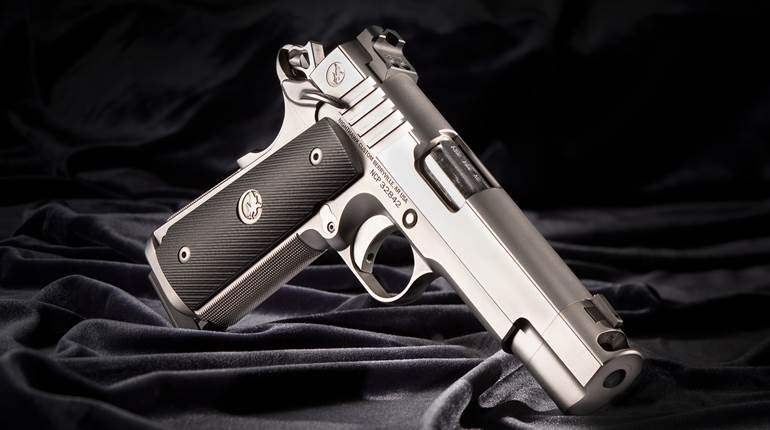
Originally published September 2007
Most gun guys know the history of the .223 Remington and that it—like so many of our popular cartridges—started life in the military. Because the military switched to metric designations sometime in the 1950s, this little .22-cal. cartridge was later called the 5.56x45 mm NATO (commonly referred to as “5.56x45 mm”).
The 5.56x45 mm surfaced in 1957 as an experimental cartridge in the AR-15 rifle. The concept was to develop a smaller, lighter military cartridge that would still be traveling faster than the speed of sound at 500 yards, and this was accomplished by using a 55-gr. boattail bullet. The AR-15 evolved into the select-fire M16 rifle that was adopted by the military in 1964.
Even though it would ultimately kill off its own .222 Rem. and .222 Rem. Mag. cartridges, Remington was quick to act, and very shortly after the military adopted the 5.56x 45 mm cartridge the firm brought out the civilian version, called the .223 Remington. Confusion followed.
The common misconception is that the two are the same; that 5.56x45 mm and .223 Rem. are the same dance partner, but with a different dress. This can lead to a dangerous situation. The outside case dimensions are the same, but there are enough other differences that the two are not completely interchangeable.
One big difference is pressure. It becomes a bit confusing, as the pressure for the two is not measured in the same way. The .223 Rem. is measured with either Copper Units of Pressure (c.u.p.) or—more recently—with a mid-case transducer in pounds-per-square-inch (p.s.i.). The military 5.56x45 mm cartridge is measured with a case mouth transducer. The different measuring methods prevent a direct comparison, as a case mouth transducer gives lower numbers on identical ammunition when compared to those from a midcase transducer. That’s because the pressure is measured later in the event, after the pressure has already peaked. According to Jeff Hoffman, the owner of Black Hills Ammunition, military ammunition can be expected to hit 60,000 p.s.i., if measured on a Sporting Arms and Ammunition Manufacturers’ Institute (SAAMI) mid-case system. Black Hills loads both 5.56x45 mm and .223 Rem., and Hoffman was a tremendous help in researching this article. He also provided these pressure specifications for the cartridges. The .223 Rem. mid-case transducer maximum average pressure is 55,000 p.s.i., while a 5.56x45 mm measured with a case mouth transducer has a maximum average pressure of 58,700 p.s.i.
While the 5.56x45 mm chamber is slightly larger than the .223 Rem. chamber in just about every dimension, the primary difference is throat length, which can have a dramatic effect on pressure. The 5.56x45 mm has a longer throat in the chamber than the .223 Rem. The throat is also commonly called the leade, which is defined as a portion of the barrel directly in front of the chamber where the rifling has been conically removed to allow room for the seated bullet. Leade in a .223 Rem. chamber is usually 0.085 inches, while in a 5.56x45 mm chamber the leade is typically 0.162 inches, or almost twice as much as in the .223 Rem. chamber. Also, the throat angle is different between the two chambers, and that can affect pressure rise and peak pressure.
SAAMI regulates cartridge overall length, but not bullet ogive design. The shape of the ogive can significantly affect how far the bullet jumps before contacting the rifling. Some 5.56 mm bullets have an ogive suitable for 5.56 chambers with the longer throat, but if they were chambered in a .223 Rem., it could result in very little, if any, “jump” to the rifling. This can increase pressures. Remember, the 5.56x45 mm already starts out at a higher pressure. If the higher-pressure 5.56x45 mm cartridge is then loaded into a .223 Rem. firearm with a short throat, the combination of the two factors can raise chamber pressures.
If you are a handloader, you must also consider that the 5.56x45 mm cartridge case may have a thicker sidewall and a thicker head, which were designed to withstand the stresses generated by the higher chamber pressures. This reduces the powder capacity of the case. If the 5.56x45 mm case is reloaded with powder charges that have proven safe in .223 Rem. cases, this reduced internal capacity can result in much higher chamber pressures.
Bottom line? It is safe to fire .223 Rem. cartridges in any safe gun chambered for 5.56x45 mm. But, it is not recommended and it is not safe to fire 5.56x45 mm cartridges in a firearm chambered for .223 Rem.
In fact, the 5.56x45 mm military cartridge fired in a .223 Rem. chamber is considered by SAAMI to be an unsafe ammunition combination and is listed in the “Unsafe Arms and Ammunition Combinations” section of the SAAMI Technical Correspondent’s Handbook. It states: “In firearms chambered for .223 Rem.—do not use 5.56x45 mm Military cartridges.”
There is no guarantee, however, that .223 Rem. ammunition will work in 5.56x45 mm rifles. Semi-automatic rifles chambered for 5.56x45 mm may not function with .223 Rem. ammunition because they are designed to cycle reliably with the higher pressure and heavier bullets of the 5.56x45 mm—particularly with short barrels. While problems are rare, they do not indicate that the ammunition or rifle are defective. Like some marriages, they are simply incompatible.
When shooting .223 Rem. cartridges in a firearm chambered for 5.56x45 mm, it’s likely that there will be a degradation in accuracy and muzzle velocity due to the more generous chamber dimensions. That’s not to say that a firearm chambered in 5.56x45 mm won’t be accurate with .223 Rem. loads, only that, on average, the .223 Rem. chambered firearms will be more accurate with .223 Rem. ammunition than rifles chambered for 5.56x45 mm firing .223 Rem.
Another issue is the twist rate of the rifling. The SAAMI specification for .223 Rem. is a 1:12" twist, and most non-AR-15-type rifles will use that rate. But, this is a cartridge that crosses a wide spectrum of uses, and as a result there is often a wide deviation from the 1:12-inch twist rate, particularly in the very popular AR-15-style guns. There are bullets available for the .223 Rem. that range in weight at least from 35 grains to 90 grains. With that wide of a spectrum, one twist rate is not going to be enough.
Firearms chambered for 5.56x45 mm often have a rifling twist rate of 1:7 inches to stabilize the long, sleek, heavy bullets used in long-range shooting. Any rifle with a 1:7" twist rate will work best with bullets heavier than 60 grains.
On the other hand, a 1:12" twist rate (most bolt-action .223 rifles) will stabilize most bullets up to 60 grains, however some longer 60-gr. bullets will not shoot well with that twist rate. Many firearms use a 1:9-inch twist, which is a very good compromise that works well with most bullets up to 70 or 75 grains. The great thing is that if you have a good barrel and quality bullets, the 1:9-inch works well with even the lightest bullets.
What does all this mean? If you have an AR-15 type firearm with a 5.56x45 mm chamber you can shoot either .223 Rem. or 5.56x45 mm safely. If your twist rate is 1:7" you should use bullets weighing 60 grains or heavier. If you have any rifle with a 1:12" twist you should shoot bullets of 60 grains or less for best accuracy. If you have a .223 Rem. rifle of any type, it is not recommended that you use 5.56x45 mm ammunition.






































